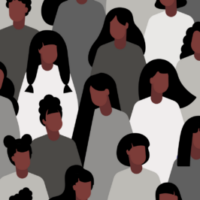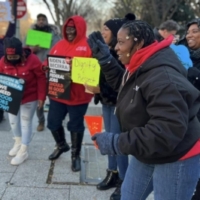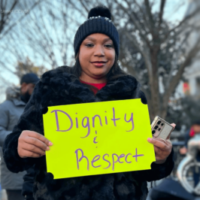Occupational segregation, the concentration or underrepresentation of groups of workers within different jobs or industries, remains a significant driver of racial and gender inequities in the labor market.
Black women play an integral role in the U.S. economy as workers, organizers, community leaders, and activists, with a long history of advocating for workers’ rights and economic security.1
Despite being at the forefront as economic drivers and mobilizers of change, Black women’s labor is segregated, underpaid, and devalued in the formal economy.2
Our analysis of recent American Community Survey data focuses on the segregation of Black women workers. To examine the extent to which Black women are concentrated in specific jobs while being locked out of others, we categorized occupations into one of four levels of representation of Black women workers. We defined these representation levels based on the proportion of Black women in an occupation relative to their proportion in the overall labor force (6.6 percent):
- Underrepresented: Black women make up 5.25 percent or less of all workers in the occupation.
- Proportionally represented: Black women make up 5.3-7.85 percent of all workers in the occupation.
- Overrepresented: Black women make up 7.9-13.1 percent of all workers in the occupation.
- Highly overrepresented: Black women make up 13.2 percent or more of all workers in the occupation.
More detailed information about our analytic methods is available upon request.

The figure above illustrates our high-level findings. Below, we detail the extent to which Black women workers are segregated into lower-paying occupations and out of higher-paying jobs, how this plays out across geography and education levels, and how the size of the wage gap differs in occupations with different levels of representation of Black women workers.
Key Findings
Across the U.S., more than half of Black women work in occupations where they are overrepresented. Over 1 in 4 Black women work in occupations where they make up at least twice as many workers in the occupation as they do in the overall workforce.
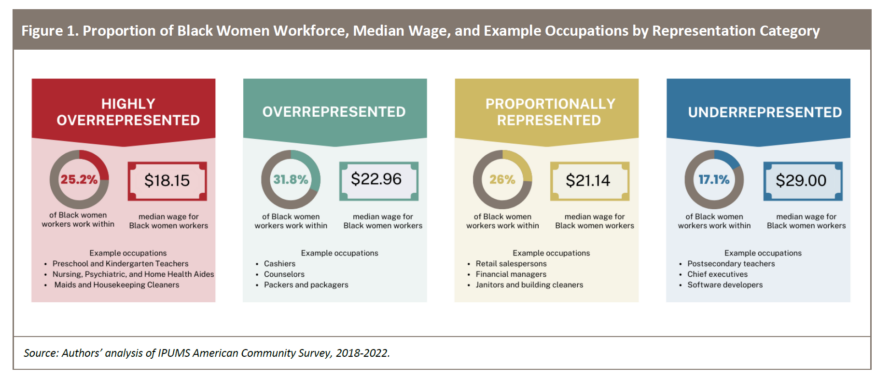
Source: Authors’ analysis of IPUMS American Community Survey, 2018-2022.
Occupations where Black women are overrepresented pay lower median hourly wages. Black women are highly overrepresented in essential but underpaid jobs including childcare workers, maids and housekeeping cleaners, personal care aides, and social workers.
Conversely, Black women workers are largely locked out of higher-paying occupations held by nearly half of the national workforce. Black women are underrepresented in occupations such as software developers, lawyers, and marketing and sales managers that tend to offer a greater level of autonomy and better benefits, in addition to higher wages.3
Proportion of Black women working in occupations where they are overrepresented or highly overrepresented by state
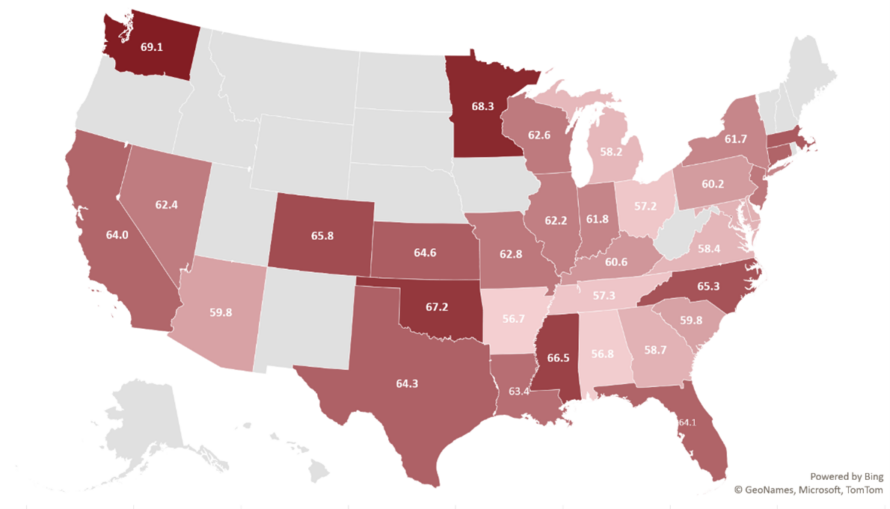
Source: Authors’ analysis of IPUMS American Community Survey, 2018-2022.
Note: States with sufficient sample sizes were included in analysis.
This stark segregation of Black women workers spans the country. Across states, a substantial proportion of Black women work in occupations where they are overrepresented, demonstrating that the unequal distribution of Black women in the workforce is not isolated to specific regions or states, but profoundly affects Black women workers across the country.
Our findings suggest that Black women workers are systematically excluded from many occupations. Even with higher education, Black women’s access to better-paying jobs where they are underrepresented remains limited.
Figure 3. Proportion of Black Women Workers with a Graduate Degree in Occupations by Representation Category
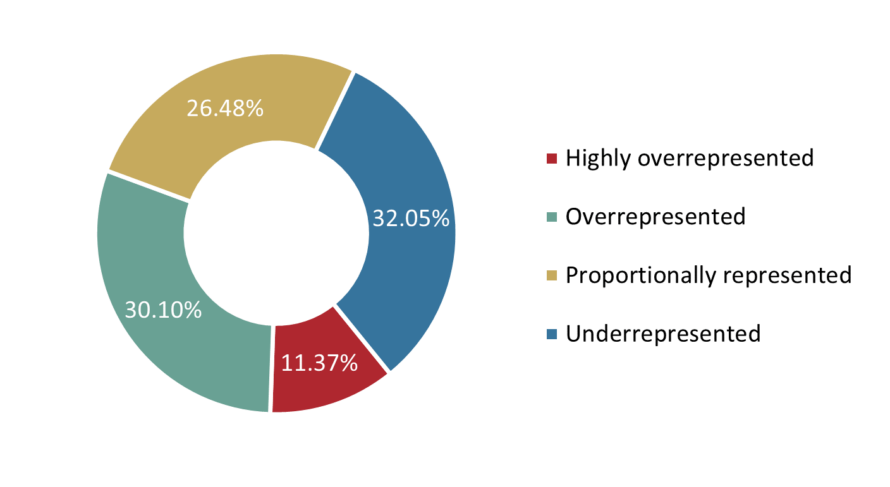
Source: Authors’ analysis of IPUMS American Community Survey, 2018-2022.
Yet the small proportion of Black women who manage to enter occupations where they are underrepresented earn higher wages – a trend observed across all levels of educational attainment. Despite earning higher wages, Black women workers in occupations where they are underrepresented also contend with larger wage gaps. At each level of educational attainment, wage disparities between Black women and white men are more pronounced in occupations where Black women are underrepresented.
We highlight two examples below to demonstrate that across education levels, Black women working in occupations where they are underrepresented versus highly overrepresented experience greater disparities in pay compared to white men working in the same jobs with the same educational attainment. Even Black women workers with a graduate degree face a significant wage penalty in underrepresented occupations, underscoring that higher education alone does not close the wage gap for Black women, who experience a lower return on their educational investment in terms of wages.
Figure 4. Example Wage Gaps between Black Women and white Men by Occupation and Education Level
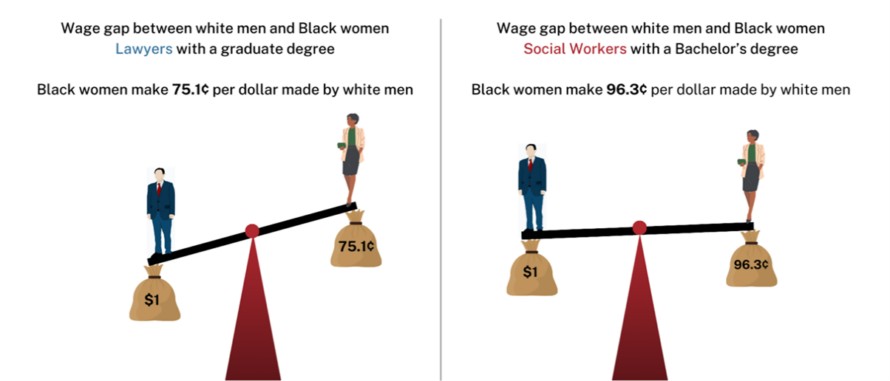
Source: Authors’ analysis of IPUMS American Community Survey, 2018-2022.
Takeaways
- Occupational segregation hinders the collective economic mobility of Black women by systematically confining Black women workers into undervalued occupations and excluding them from higher-paying jobs.
- Occupational segregation of Black women workers is a nationwide issue that demands national attention, dialogue, and action to raise job quality in occupations where Black women are overrepresented, desegregate work, and support Black women’s economic prosperity and overall wellbeing.
- The persistent confinement of Black women to certain occupations drives lower earnings for all Black women workers, perpetuating wage disparities across levels of educational attainment. These findings challenge the notion that education or other forms of human capital can resolve occupational segregation and instead point to systemic and institutional forces as root causes.
- Black women are paid less for the same work done by white men with the same educational attainment, and disparities are larger in occupations where Black women are underrepresented. This underscores the need for comprehensive solutions to address cultural biases, discriminatory employment practices, and limited advancement opportunities in these workplaces.
Discussion and Recommendations
The systematic segregation of Black women’s labor into underpaid and undervalued jobs perpetuates a restrictive labor market, stifling Black women’s wages and collective economic mobility. This segregation also leads to worse outcomes in job quality for Black women workers, who experience lower autonomy, higher rates of workplace discrimination, unpredictable and inflexible work schedules, and limited access to benefits like employer-sponsored health insurance and paid leave.4
Occupational segregation of Black women workers is deeply rooted in policy choices, racialized and gendered stereotypes, and structural racism dating back to chattel slavery. However, transformative approaches that confront the historical legacies of slavery and systemic racism and center Black women as key stakeholders can uproot systemic injustice and promote economic security and overall wellbeing for Black women and their families.
Addressing occupational segregation requires bold and sustained policy, program, and narrative solutions to remove structural barriers limiting Black women’s opportunities for high-quality work and economic mobility, dismantle racist stereotypes and narratives, and ensure every job is a good job. Centering Black women’s voices and expertise in this work is critical. Through conversation with Black women workers across the country about their roles and experiences with occupational segregation, we uplift narratives centered on dignity, meaning making, and abundance.5
The Congressional Caucus on Black Women and Girls developed a comprehensive, multi-faceted policy approach based on the Black Women Best framework. A Black Women Best policy approach is needed to address occupational segregation in the context of intersecting systems and structural barriers that have impacted Black women and communities for generations.6
Employment policies and practices such as paid family and sick leave, pay transparency, flexible and predictable scheduling, expanded collective bargaining, and stronger anti-discrimination law enforcement can help build worker power, promote pay equity, and desegregate opportunity. Additionally, policies such as universal health care, student loan forgiveness, eliminating criminal legal fines and fees, and expanding high-quality and affordable childcare assistance can have wide-reaching impacts on Black women workers and help build an economy where everyone can thrive.

| Highly overrepresented | 25.17% | 9.14% |
| Overrepresented | 31.83% | 19.71% |
| Proportionally represented | 25.95% | 26.45% |
| Underrepresented | 17.05% | 44.70% |
Source: Authors’ analysis of IPUMS American Community Survey, 2018-2022.

| Highly overrepresented | $18.15 | $19.37 |
| Overrepresented | $22.96 | $24.92 |
| Proportionally represented | $21.14 | $23.87 |
| Underrepresented | $29.00 | $31.86 |
Source: Authors’ analysis of IPUMS American Community Survey, 2018-2022.

| Highly overrepresented | 29.40% | 31.33% | 28.97% | 16.81% | 11.37% |
| Overrepresented | 27.92% | 28.56% | 33.65% | 35.17% | 30.10% |
| Proportionally represented | 32.83% | 27.75% | 23.54% | 25.52% | 26.48% |
| Underrepresented | 9.85% | 12.36% | 13.84% | 22.50% | 32.05% |
Source: Authors’ analysis of IPUMS American Community Survey, 2018-2022.

| Highly overrepresented | $14.72 | $16.28 | $18.19 | $22.34 | $28.09 |
| Overrepresented | $16.42 | $17.45 | $20.84 | $29.27 | $35.75 |
| Proportionally represented | $14.07 | $16.07 | $19.20 | $27.18 | $34.26 |
| Underrepresented | $17.96 | $18.78 | $23.29 | $33.80 | $43.91 |
Source: Authors’ analysis of IPUMS American Community Survey, 2018-2022.

| Highly overrepresented | 94.30 | 86.90 | 84.27 | 80.21 | 81.62 |
| Overrepresented | 93.46 | 83.09 | 82.12 | 85.83 | 81.05 |
| Proportionally represented | 78.32 | 76.51 | 78.21 | 75.63 | 75.73 |
| Underrepresented | 81.03 | 73.75 | 75.24 | 74.44 | 76.01 |
Source: Authors’ analysis of IPUMS American Community Survey, 2018-2022.
Detailed information about our data and analytic methods is available upon request (hchimowitz@nelp.org).
Go Deeper
Related to
- Analysis of Black Women’s Historical Labor Trends & Systemic Barriers to Economic Mobility (Cincinnati: Women’s Fund of the Greater Cincinnati Foundation’s Research Committee, 2020), https://www.womensfundingnetwork.org/wp-content/uploads/2020/10/Final_Hist_Black_Women__Report_Design_reduced.pdf; And Still I Rise: Black Women Labor Leaders’ Voices, Power, and Promise (Washington DC: Institute for Policy Studies, 2015), https://ips-dc.org/wp-content/uploads/2023/10/And_Still_I_Rise_Black_Women_Labor_Leaders_Report.pdf
- Bearing the Cost: How Overrepresentation in Undervalued Jobs Disadvantaged Women During the Pandemic (Washington DC: U.S. Department of Labor, 2022), https://www.dol.gov/sites/dolgov/files/WB/media/BearingTheCostReport.pdf; Jocelyn Frye, Rejecting Business as Usual: Improving Employment Outcomes and Economic Security for Black Women (Washington DC: National Partnership for Women & Families, 2023) https://nationalpartnership.org/report/improving-employment-outcomes-economic-security-for-black-women/; Janette Dill and Mignon Duffy, “Structural Racism And Black Women’s Employment In The US Health Care Sector,” Health Affairs 41, no. 2 (2022): 265-272, https://www.healthaffairs.org/doi/10.1377/hlthaff.2021.01400; Asha DuMonthier, Chandra Childers, and Jessica Milli, The Status of Black Women in the United States (Washington DC: Institute for Women’s Policy Research, 2017), https://iwpr.org/wp-content/uploads/2020/08/SOBW_ExecutiveSummary_Digital-2.pdf
- Ofronama Biu, Batia Katz, Afia Adu-Gyamfi, and Molly Scott, Job Quality and Race and Gender Equity (Washington DC: Urban Institute, 2023), https://www.urban.org/research/publication/job-quality-and-race-and-gender-equity
- Jonathan Rothwell and Steve Crabtree, Not Just a Job: New Evidence on the Quality of Work in the United States (Washington DC: Gallup, Inc., 2019), https://www.luminafoundation.org/wp-content/uploads/2019/11/not-just-a-job-new-evidence-on-the-quality-of-work-in-the-united-states.pdf; Jessica Shakesprere, Batia Katz, and Pamela Loprest, Racial Equity and Job Quality: Causes Behind Racial Disparities and Possibilities to Address Them (Washington DC: Urban Institute, 2021), https://www.urban.org/sites/default/files/publication/104761/racial-equity-and-job-quality.pdf; Biu, Katz, Adu-Gyamfi, and Scott, Job Quality and Race and Gender Equity; Ofronama Biu and Afia Adu-Gyamfi, Black Women and Vulnerable Work: Occupational Crowding of Black Women Lowers Their Wages and Well-Being (Washington DC: Urban Institute, 2024), https://www.urban.org/sites/default/files/2024-03/Black-women-vulnerable-work.pdf
- Kemi Role and Shayla Thompson, Purpose & Resistance: Black Women Workers Confronting Occupational Segregation (New York: National Employment Law Project, 2024), https://www.nelp.org/publication/purpose-resistance-black-women-workers-confronting-occupational-segregation/
- Kendra Bozarth, Grace Western, and Janelle Jones, Black Women Best: The Framework We Need for an Equitable Economy (New York: Roosevelt Institute, 2020), https://rooseveltinstitute.org/wp-content/uploads/2020/09/RI_Black-Women-Best_IssueBrief-202009.pdf; Bonnie Watson Coleman, Yvette D. Clarke, and Robin Kelly, An Economy for All: Building a “Black Women Best” Legislative Agenda (Washington DC: Congressional Caucus on Black Women and Girls, 2022), https://watsoncoleman.house.gov/imo/media/doc/bwb_report_20220331.pdf
Related Resources
All resourcesShernice Mundell, Former Federal Employee

Worker Voices
2025 NELP Policy and Advocacy Agenda

Policy & Data Brief
2024 Impact Report: 55 Years of Fighting for Workers

Report

